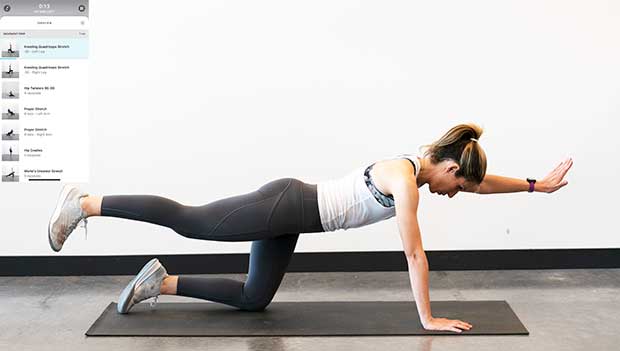
By clicking on the product links in this article, we may receive a commission fee at no cost to you, the reader. Sponsorships and affiliate commissions help support our research so we can help you find the best products. Read full affiliate disclosure here.
Thanks to the Future fitness app, you no longer have to have a massive budget to get a specially designed workout plan. Future brings personalized training plans straight to your iPhone, Android, or Apple Watch. Using professional trainers who tailor workouts based on the equipment you have, your abilities, and your schedule, Future seamlessly integrates fitness into your routine and schedule.
As a longtime runner and health and wellness writer, I will break down everything you need to know to decide if this personal training app is in your future.
What is Future?
The Future app is a personal training platform that emphasizes individualized training through virtual workouts. Future sets itself apart by making consistency a priority. With Future, you’ll be paired with a coach best suited to help you reach your goals, with the option to adjust your programming (or coach) as needed. Future coaches are trained to provide continuous, personalized support for each member. While virtual personal training isn’t new, Future training partners the user with their coach for better accountability and an increased likelihood of results.
My Ratings
- Overall: 4.7/5
- Value/Price Point: 3.5/5
- App: 5/5
- Easy to Follow: 5/5
- Goal Attainment: 5/5
- Customer Support: 5/5
My Experience With Future
Four months before I started using Future, my workout routines and fitness life crumbled with one terrible misstep—literally. I went for an overhead while playing tennis, and when I landed, I heard a terrible pop. I had strained my calf, and all my favorite activities—tennis, running, hiking—were put on an insufferable hold.
As soon as I started rehabbing my calf, I realized I needed to protect my muscles from other injuries through strength training. The thing is, I find strength training boring, and I dislike workout classes, which are great for burning calories but too random to be beneficial, in my opinion. I figured my best bet would be to work with a personal trainer. When I first heard of Future, I wasn’t sure if an app could help me stick to a strength training routine. I needed peer pressure from a group (not my favorite) or someone by my side to motivate me to do the work.
The Future app proved to be exactly what I needed.
I chose a knowledgeable coach named David Eackloff, who has an M.S. in exercise science and fitness certifications in Strength and Conditioning (NSCA), Collegiate Strength and Conditioning (SCCC), Advanced Olympic Weightlifting (AOLC), and many other specializations with acronyms. Oh, and he coaches Olympic athletes, no big deal. He also plays tennis and is extremely active, so I trusted him to help me get back on track and on the court. My goals were to build muscle and ease into my previous physical activities. David encouraged me to specify my fitness goals, so I made it my mission to get back to running two miles nonstop without pain and to participate in a tennis tournament within three months.
David programmed three days of strength per week, two days of cardio, and one full day of rest. With this structure, I realized I had been neglecting another part of my fitness life pre-injury—balance. For example, one study, Training Load, Injury, and Athletic Performance: Mastering the Trifecta, examined how a coach can help an athlete optimize their training load.(1) Having David organize my workout schedule got me over this fitness hurdle. From the get-go, Future was helping me ace my comeback.
My first month was pretty rudimentary, but I understood why. My body needed to re-learn how to handle lifts, and David and I wanted to ensure nothing would aggravate my injury. I was also in the middle of a cross-country move, and my (already limited) dumbbell supply was unavailable. I had to perform the workouts where and when I was able with only resistance bands. Despite all these limitations, the routines were challenging and fun. Most of my notes from the first month were complaints about push-ups and gripes about delayed onset muscle soreness (DOMS). David tolerated my whining and helped me get through the first month with relative ease.
Month two was when I really started to notice changes in my strength, endurance, and muscle tone. Change doesn’t happen overnight, no matter which app you use, but consistency will lead to progress.
I (finally) had the random pieces of my home gym out of boxes, and David plugged the weights I had into the new workouts. When using my 15-pound dumbbells and 20-pound kettlebell got too easy, I splurged on a pair of 25s. It’s been years since I thought of investing in heavier weights, and I don’t think I would have made that leap without my experience with Future. These new weights were like a tangible, visual representation of my progress, and I was stoked. Thanks to David’s accountability, I stayed (mostly) on track with my lifting days and worked to 1.75 pain-free running miles (so far). I am also back on the tennis court and looking forward to a match next month.
Overall, I loved Future. It helped me achieve my specific goals, which is exactly how it’s supposed to work. There are many benefits and some improvements that I think everybody will agree on, which I’ll take you through here.
What I Liked
- Personalization. When it comes to fitness, nothing beats one-on-one programming and attention. As an injured weekend warrior, I needed this kind of guidance. I know this would also benefit beginners who need a lot of accountability, as well as advanced athletes with specific performance goals.
- User Experience (UX). The app itself was incredibly easy to use, and is aesthetically pleasing. The audio and visual instructions were informative without being overbearing.
-
Quality coaching. I don’t know about you, but I’ve experienced my fair share of subpar coaching. In group settings, I’ve seen workouts put together like the moves were drawn out of a hat, with no goal other than to get your heart rate up. I’ve also had coaches who preached overtraining and coaches that never pushed hard enough.
Future has a lot of different trainers with different styles and experiences, but they share one commonality: they know what they are doing. What I really liked about working with my Future coach was how he gave me accountability with just enough autonomy to help me believe in my strength. - Fun features. One feature that put me over the moon was the ability to share my screen over Bluetooth to any device, like my big-screen TV, for a more immersive experience. Plus, you can choose in-app music to jam out to or easily navigate from the app to your Spotify account to have your own music playing during your workout. Compatible watches will let you receive audio cues about your heart rate, which is excellent feedback.
- Accessibility. You can use the app anytime, anywhere. Your workouts will be designed to match the equipment you already have, so no one will be trying to sell you a gym membership or a special set of dumbbells.
What Could Be Better
- Price. There’s no way around it: the Future app is expensive. The cost is $199 per month ($149 per month if you sign up for an annual membership), and that’s prohibitive for some people. But just because it’s pricey doesn’t mean the value isn’t there. And if you compare it to in-person personal training, which can range from $65 to $100 per hour, it’s a bargain. If you are willing to invest in your fitness, it’s worth the high price tag.
-
Connectivity. One major gripe people have with the Future app is its exclusivity with Apple products. The integration with the Apple watch is seamless, but if you’re wearing a Garmin, your activities aren’t automatically loaded into the app until you sync in the Garmin app. It’s certainly not a deal-breaker, but it’s a pain in the butt.
I asked Rishi Mandal (Future co-founder and CEO) via email if there are solutions on the horizon. "Future recently launched on Android," Mandal said, which is welcome news for non-Apple users. "This offers compatibility with Android wearables and any watch that operates on Wear OS 3.0 or above, such as the Google Pixel Watch and Samsung Galaxy Watch for workouts and activity monitoring."
We’re hopeful that tracking all activities in Future with all types of devices is the next wave. - Real-time feedback. The option of filming yourself and sending tape for analysis works pretty well. That’s probably the best way to get feedback on your form for virtual training. For those who need on-the-spot corrections to learn, a virtual coach may not be the right fit.
- Nutrition. If you’re looking for an app to help you with insights into your diet and nutritional needs, then it would be better to download a nutrition-based app like Noom or MyFitnessPal. Future is more fitness-focused. While some coaches may be able to help you with diet (depending on their area of expertise), there are better options in the app store for support, community, and food tracking. But that’s for right now. I don’t know too much, but Mandal hinted that the next iteration of Future could have more holistic features, such as health and wellness coaching.
How Does Future Work?
SPECS
- Price: $199/month
- Free trial: No
- Gym membership required: No
- Ability to change coaches: Yes
- Compatible with: Apple Watch, Apple Health, Bluetooth devices, Android phones, Google Pixel Watch, and Samsung Galaxy Watch
Getting Started
Before you make an account on the Future app, you’ll be asked to take a quiz to pair you with your coach. The questions dig into your current fitness levels, your personal vision of success, gender, weight (you don’t have to answer if you don’t want to), goal weight, and any obstacles preventing you from your goals.
Next, the quiz asks what you’re looking for in a coach. It takes into account if you want a high-energy drill sergeant, a relaxed Zen master, or something in between. It also goes through the basics, like if you prefer a male or female coach. Based on this information, you’ll get matched with four coaches. You can read their bios and specialties and choose one.
According to studies that compared personal training versus self-directed workouts, those who used a trainer saw significantly more improvements than those left to their own devices.(2) Future takes this science-based approach and gives its clients an ultra-personalized workout experience.
When you choose your coach, you’re choosing your buddy for the next few months. They program a weekly workout routine tailored to your needs, abilities, schedule, and goals, and they check in with you every weekday to see how it’s going. You’ll also have video calls every month or so to chat about your progress.
What sets Future apart from other apps is this individualized approach. In addition to the hyper-focus on personal training, your Future coach will factor in your other fitness classes or activities and consider them as they build your programming.
Personalized Programming
After you select your coach and sign up for the app, you will choose a time to speak with them via FaceTime. In this initial call, you should expect to go over your quiz answers in more detail. Your coach will ask about your goals, setbacks, personal preferences, and limitations. They will also ask about how frequently you want to exercise, what days work for you, and what at-home gym equipment you own or if you have a gym membership. Don’t worry; no gym membership is required! Your Future coach can set up workouts for people using bodyweight only if needed.
From there, you sit back and relax while they use your information to create a customized workout plan. The workouts "drop" weekly, and you can preview the routines and your weekly workout schedule in the app.
The Coaches
I reached out via email and asked Future co-founder and CEO Rishi Mandal how the Future coaching program works and how coaches are chosen for the platform. Future has credentialed trainers with varying backgrounds, including lifelong coaches and Olympic and former Division I athletes. But what’s most important to Mandal when hiring coaches is how they will diversify the current staff to provide a coach for everyone who wants to try Future. The emphasis is on building partnerships, which has been proven in studies to play a huge role in athlete success.(3)
When I tested out the introductory quiz, I found this wasn’t just lip service. For example, you can enter that you’re a 50-year-old male with an injury looking to lose weight and interested in an intense coach, and the results will be very targeted to your request. Similarly, if you enter that you’re a 35-year-old female with the goal of improving athletic performance and need a cool-headed fitness mentor, your results will be completely different and, to be honest, eerily spot-on.
Finally, all of the coaches are full-time employees of Future, which means this isn’t their side hustle. They are dedicated to their Future clients.
Workouts
Your assigned workouts will vary based on your fitness level and goals. You will likely start with some fundamentals to help your coach gauge your capabilities and correct any form issues.
In the app, you’ll press play on your workout, and then it will take you through each move with visual and audio cues. Your coach’s voice will pop in with specific instructions on some exercises or general encouragement. It takes you through the whole workout as though it is an exercise video, but you log your number of reps and weight in the app.
Your coach will also enter your non-Future fitness activities into the app. For example, if you have a yoga class each Saturday, it will be on your calendar. Similarly, if cardio is part of your plan, your coach can schedule that on non-lifting days.
Coaching Feedback
One of the most beneficial parts of Future is the level of accountability you’ll get from your coach. They will check in daily to psyche you up for the workout or see how your recovery day is going. If you miss a day, they’ll slide right into your DMs with a “Hey, what’s up?!”
Mandal says coaches exchange an average of four daily messages with clients, including daily check-ins, instructions, and feedback. A nifty app feature is the ability to film yourself as you complete a move and send it to your coach. That way, if you feel unsure about your form or need a weight adjustment, your coach can give you specific guidance. While they are not there in real-time, they will get back to you within 24 hours.
How Much Does the Future App Cost Each Month?
Future costs $199 per month if you choose the month-to-month plan. If you sign up for the annual plan, it will cost $149 per month. These prices can change, so verify your membership cost when you sign up.
Does Future Offer a Free Trial?
Future currently does not offer a free trial; however, they are running a deal right now that will get you 50% off your first month.
Alternatives
Future App vs. Peloton App
Looking at the Peloton App versus Future is comparing apples to oranges. Peloton only offers group classes—you don’t get a personalized coach—and while it’s not totally necessary, it’s nice to have the Peloton equipment (rower, treadmill, or bike) to get everything out of the app experience. So if you are looking for a more customized experience with more accountability, Peloton won’t cut it. However, it’s far more affordable than Future. The cost is just $44 a month, and you can get a free trial month.
Future App vs. Tonal
Tonal bills itself as the world’s smartest gym and (without a doubt) is pretty cool. If you’re unfamiliar, Tonal is a complete smart home gym workout mirror that can be installed in a compact space. When comparing Future versus Tonal, there are quite a few differences. First, Tonal requires you to buy its equipment, which costs around $4,500. You’ll also have to pay the monthly membership fee of about $50. Is it worth it? Here’s our in-depth Tonal review with everything you need to know.
TLDR: With Tonal, you get a complete home gym and access to countless workout programs. But if you are looking for one-on-one coaching, Future will still win this race. While you can get personal training with Tonal, it can be difficult to navigate and comes at an additional fee.
Customer Reviews
Here are a few unbiased reviews we've collected from app users to highlight the pros and cons of the Future app.
High-quality coaches, high-quality app
"Future's app is smooth, easy to use, and illustrates techniques well with video. Even as someone who has worked out for years, the trainers in the videos use impeccable form and allow you to introspect on your movement. The coaches are the stars. My coach is incredibly knowledgeable, has a track record of athletic success, and has tailored my schedule for my own goals. He pushes me, and I've seen substantial progress. I recommend Future to anyone that's serious about getting fit." - Trustpilot (April 26, 2022)
"I have some injuries and some changes to my body after pregnancy, but [my trainer was able] to work around them and help me get my strength back." - Mashka L.
5 months, worse than when I started
"To be fair, I was 100% invested in the program when I started. Months 1 and 2 were good. I was happy and recommending this app to friends. After that, the results were waaaay too slow for my liking. I asked to increase the intensity a little and she went too high for me. She was super nice and really good at switching out exercises, listened to my concerns, and understood my health issues. Had to pause a month due to a medical issue, but reactivated for 2 more months with the hopes to focus on weight loss and nutrition. After 2 months, I gained weight! It put me in a downward spiral I’m still trying to get out from." - Turtle (Apple App store on November 12, 2022)
FAQs About the Future App
What comes in the Future welcome kit?
Future no longer sends a welcome kit. Previously, when you signed up for Future, you received a water bottle and the option to lease an Apple Watch. But now that the app is compatible with other devices, they don’t offer this service.
Can you pick your own coach with Future?
After you take a quiz about your fitness needs and goals, you’ll receive a list of four coaches. You can read their bios and review their credentials and personalities, then choose the one you think is best for your training needs. If you’re not gelling with your coach, you can switch it up; no hard feelings!
Do you need any special fitness equipment with the Future App?
You do not need any special fitness equipment to use Future. Your coach will design your program using what you have access to. So if you only have a cat-fur-covered yoga mat and soup cans, that’ll do.
What fitness level is the Future fitness app best for?
While the Future app has made our list of the best workout apps for beginners, the coaches can help even elite-level athletes. As long as you can identify your goals and are motivated, the app can help you level up.
Does the Future App help with nutrition?
In short, no. The Future app doesn’t currently offer a nutrition plan in the way that Noom or other weight loss apps might. Your coach can make suggestions, but if you're looking for help dialing in your diet, a nutritionist or specialized app would be great to use with Future.
Who Tried It
Hi! I’m Ali Nolan, author of Master the Marathon and a fitness and health journalist, wellness enthusiast, and four-time marathoner. In addition to more than a decade of experience testing different apps, training plans, exercise fads, and gear, I am a research-obsessed writer who values scientifically backed training methods.
Why Trust Us?
ACTIVE.com's editorial team relies on the knowledge and experience of fitness and wellness experts including competitive athletes, coaches, physical therapists, nutritionists, and certified trainers. This helps us ensure the products we feature are of the highest standard. Collectively, the team has spent countless hours researching equipment, gear, and recovery tools in order to create the most accurate, authentic content for our readers. Customer satisfaction is also a key part of our review process, which is why we only feature products that are highly rated.
Final Takeaway
Here’s the deal—as with any fitness app or service, you get what you put into it. But Future reminds me of that old saying: "Only you can do it, but you can’t do it alone."
I believe my relationship with my coach David and his expertise helped get me on track to living my best active life. He, and the app, had me set goals and take ownership of my physical health. In my opinion, Future can do the same for exercise newbies, multisport veteran athletes, and anyone in between.
When you’re signing up, think beyond month one. Give yourself 60 days to assess if you are making progress. If your coach gets you to do your workouts and start seeing changes, it might be worth the hefty price tag.
I know that for many people, it’s hard to know where to start when it comes to working out. And then, at times, it’s hard to keep going. If you’re nodding in agreement, I highly recommend you try Future, as you’ll be given a blueprint for success.
Our Experts
- Alexandra Ginos, MBA, RD, CSP, nutritionist and fitness expert
- Roger Lockridge, 20 year fitness industry expert
- Ali Nolan, marathon runner
- David J. Sautter, NASM CPT, FNS, PES; ACE SES, personal trainer and fitness expert
- Cory Kessler, CPT, FNC, health and wellness writer
- Daniel Preiato, RD, CSCS, sports nutrition expert
- Erin Chancer, CNC, expert health and wellness writer
- Katie Simpson, CPT, health and wellness writer
- Dr. Jacob Wilson, PhD, CSCS*D, training expert
- Lindsay Boyers, functional nutritionist
- Elspeth Huyett, cycling expert
- Gaby McPherson, nutrition expert
- Krisitne Golden, triathlete
- Lindsey Cooke, CNT, nutrition therapist
- Karla Tafra, nutritionist and yoga instructor
- Rachael Gonzalez, health and wellness writer
- Sosha Lewis, certified sleep coach, health and wellness writer, CrossFit veteran
- Frieda Johnson, expert health and wellness editor
References
- Kronemer, C. (November 7, 2022) Training Load, Injury, and Athletic Performance: Mastering the Trifecta. National Federation of Personal Trainers (NFPT). Retrieved June, 2023 from https://www.nfpt.com/blog/training-load-injury-and-athletic-performance-mastering-the-trifecta
- Storer TW, Dolezal BA, Berenc MN, Timmins JE, Cooper CB. Effect of supervised, periodized exercise training vs. self-directed training on lean body mass and other fitness variables in health club members. J Strength Cond Res. 2014 Jul;28(7):1995-2006. doi: 10.1519/JSC.0000000000000331. PMID: 24276303.
- Foulds SJ, Hoffmann SM, Hinck K, Carson F. The Coach-Athlete Relationship in Strength and Conditioning: High Performance Athletes' Perceptions. Sports (Basel). 2019 Dec 4;7(12):244. doi: 10.3390/sports7120244. PMID: 31817157; PMCID: PMC6956380.
About the Author

Ali Nolan is the author of Master the Marathon: The Ultimate Training Guide for Women. She is the former features editor for Runner’s World and has written for Women’s Running, Self, Sport Literate, and Livestrong. Ali has been featured as a running expert on Good Morning America with Amy Robach, as well as the podcasts 8020 Endurance, I'll Have Another with Lindsey Hein, and Greenletes.
Get ACTIVE on the Go


Couch to 5K®
The best way to get new runners off the couch and across the finish line of their first 5K.
Available for iOS | Android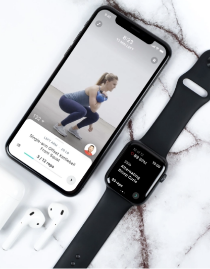
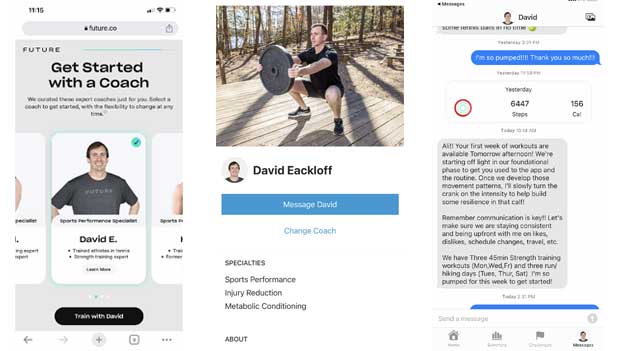
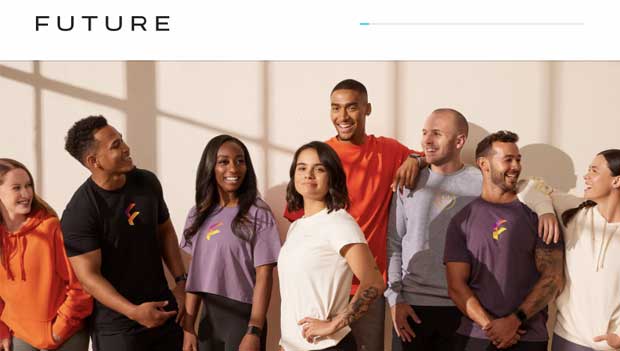
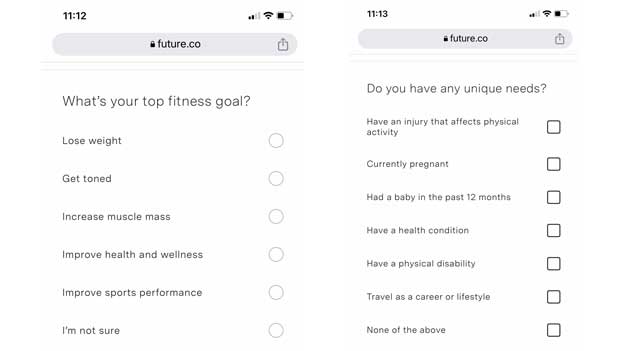







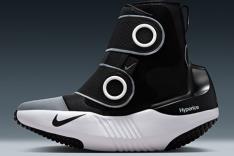

Discuss This Article